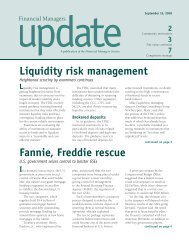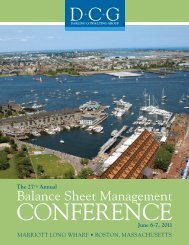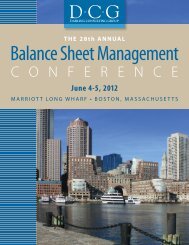The Importance of Auditing the Asset/Liability Management Process
The Importance of Auditing the Asset/Liability Management Process
The Importance of Auditing the Asset/Liability Management Process
You also want an ePaper? Increase the reach of your titles
YUMPU automatically turns print PDFs into web optimized ePapers that Google loves.
<strong>Auditing</strong> <strong>the</strong> ALM <strong>Process</strong><br />
Loans May Continue<br />
to Prepay/Modify As Rates Rise<br />
Be careful when originating floating-rate loans.<br />
Similar to <strong>the</strong> way that fixed-rate borrowers have<br />
forced you to rewrite <strong>the</strong>ir deals as rates have<br />
fallen, floating-rate borrowers may find it more<br />
beneficial to fix those loans as rates continue to rise.<br />
This would present an economic benefit if <strong>the</strong>se<br />
loans remain with your bank, but how can you be<br />
assured that competitive pricing won’t lure your<br />
customer(s) elsewhere? Remember, prepayment<br />
penalties should be applied whenever possible,<br />
even on variable-rate loans.<br />
A Shift in Deposit Mix May Arise<br />
Don’t be surprised if <strong>the</strong> CD customers that shifted<br />
<strong>the</strong>ir money into savings and money-market deposit<br />
accounts shift back into CDs when <strong>the</strong> price is right.<br />
We’ve noticed that this trend has already begun to<br />
unfold for some banks, creating an even greater current<br />
earnings challenge.<br />
Also, CD customers (especially IRA customers)<br />
have started to extend <strong>the</strong>ir maturities (three to<br />
five years) and take advantage <strong>of</strong> <strong>the</strong> bank’s highest-yielding<br />
products. While this may appear to<br />
present a potential benefit since long-term CDs<br />
imply money is locked in for a sustained period<br />
<strong>of</strong> time, it is important to recognize that, at today’s<br />
current low rate levels, in most cases <strong>the</strong> cost <strong>of</strong> early<br />
withdrawal is relatively immaterial. Should rates<br />
rise and <strong>the</strong>se CDs become “broken,” <strong>the</strong> bank will<br />
have paid a three- to five-year rate on what will have<br />
turned out to be a much shorter-term deposit. Again,<br />
this would delay <strong>the</strong> potential earnings benefits in<br />
a rising-rate scenario.<br />
A Potential Liquidity Crunch?<br />
Some banks could see deposit balances decline<br />
if rates rise and depositors flee to o<strong>the</strong>r, more<br />
attractive nonbank investment alternatives.<br />
Should this worst-case scenario unfold, liquidity<br />
levels could be squeezed at a time when<br />
<strong>the</strong> economic environment presents more opportunities<br />
for asset growth. For banks that have<br />
seen borrowing levels increase in <strong>the</strong> current<br />
environment, contingency plans should be put<br />
in place now to ensure that funding constraints<br />
do not restrict <strong>the</strong> potential for earnings growth<br />
in <strong>the</strong> future.<br />
Collateral Values Will Deteriorate<br />
Some banks have leveraged into <strong>the</strong> investment<br />
portfolio to supplant a s<strong>of</strong>t lending market. For <strong>the</strong>se<br />
banks, liquidity levels may have improved—assuming<br />
<strong>the</strong> investments can be used as collateral at <strong>the</strong> Federal<br />
Home Loan Bank (FHLB) or in <strong>the</strong> repo market. As<br />
you know, <strong>the</strong> fair value <strong>of</strong> <strong>the</strong>se assets will decrease<br />
as interest rates rise. Depending on <strong>the</strong> mix <strong>of</strong> investments,<br />
this could have a meaningful impact on future<br />
liquidity levels (that is, borrowing capacity).<br />
Can Deposit Rates Be Lagged As Much As <strong>the</strong><br />
Model Assumes?<br />
Should liquidity get squeezed, banks could find<br />
<strong>the</strong>mselves pricing more aggressively to keep existing<br />
deposit customers as well as to attract new<br />
ones. In many markets, current CD rates are well<br />
below (50 to 100 bps) alternative wholesale funding<br />
resources. Should market rates rise, bank CD rates<br />
could be forced to increase at a speedier pace. To<br />
assume <strong>the</strong> bank will increase CD rates 100 to 150<br />
bps, as many bank models do, will likely understate<br />
<strong>the</strong> impact <strong>of</strong> deposit pricing pressures in a risingrate<br />
scenario. Increasing CD rates 200 bps, in fact,<br />
may not be enough.<br />
Banks shouldn’t be surprised if CD rates need to be<br />
increased more significantly. It’s a good idea to plan<br />
your defensive strategies now to minimize this risk.<br />
Ignorance Is Bliss<br />
All jokes aside, too <strong>of</strong>ten community banking<br />
institutions use <strong>the</strong> asset/liability management<br />
(ALM) audit merely to make certain <strong>the</strong> model’s<br />
financial data is valid and, consequently, view<br />
this project inappropriately as ano<strong>the</strong>r futile<br />
exercise required to satisfy <strong>the</strong>ir regulators.<br />
This audit can have more serious implications<br />
than many bank executives acknowledge. As<br />
implied in <strong>the</strong> few examples above, an ALM<br />
process that is flawed in its capacity to identify<br />
and address all <strong>the</strong> risks, both obvious and<br />
unforeseen, could be very costly to your bank’s<br />
future performance.<br />
It is in <strong>the</strong> best interest for even <strong>the</strong> highestperforming<br />
institutions to reassess <strong>the</strong>ir process<br />
continuously to ensure ALCO can clearly identify<br />
<strong>the</strong> key business risks that may affect <strong>the</strong>ir perception<br />
<strong>of</strong> <strong>the</strong> bank’s risk/return makeup. Past<br />
performance is behind us. Future performance will<br />
22 BANK ACCOUNTING & FINANCE OCTOBER–NOVEMBER 2004





